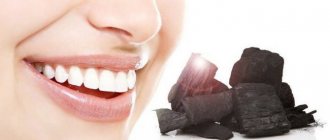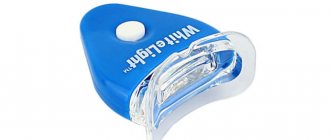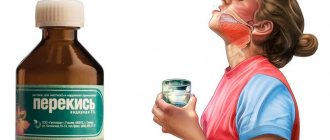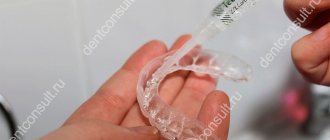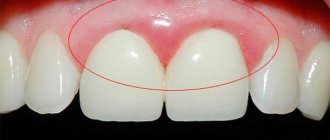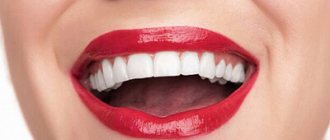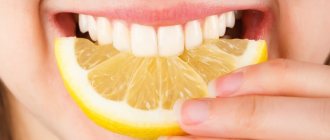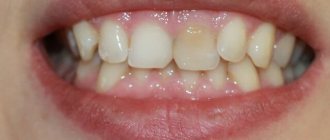From this article you will learn:
- how to whiten teeth at home without harm,
- professional home whitening systems,
- What are the dangers of bleaching with activated carbon, soda or hydrogen peroxide.
The article was written by a dentist with more than 19 years of experience.
In some cases, teeth whitening at home can be no less effective than at the dentist's office. The most effective way to do this is with special home whitening kits, consisting of whitening gel and dental trays. The second most effective remedy is probably the use of certain types of whitening strips.
It must be admitted that most patients do not like to go to doctors, and therefore they are much more comfortable doing teeth whitening at home than going to the dentist. In addition, the cost of a home whitening course will average about 4,000 rubles, which is significantly cheaper than professional whitening techniques such as Zoom®, the cost of which starts from 15,000 rubles.
How to whiten your teeth at home quickly and effectively - this can be done using Opalescense kits or Crest 3D White whitening strips:
How effective is home whitening?
The best at-home whitening products will lighten your teeth by about 4-6 shades (on the Vita Teeth Shade Chart), but will require daily use for 10-20 days. Whitening at the dentist most often provides a similar result, but the procedure will only last 1 hour. But the best whitening pencil or toothpaste can change the color of your teeth by only 1-2 shades.
You can evaluate for yourself how effective home teeth whitening will be. A noticeable result of 4-6 tones can be obtained only if your teeth initially have a yellow tint. Here you can really notice the before and after difference. But if you want to make already quite light teeth whiter, the whitening effect is unlikely to be more than 1-2 tones (and not only after home remedies, but even professional whitening).
Only teeth with a yellowish tint respond well to whitening. If your teeth have a gray or brown tint, whitening (both at home and professional) will be an ineffective procedure.
Why do teeth turn yellow and darker?
The hard tissues of the tooth consist of two layers - translucent enamel and underlying darker dentin. Over the course of life, the enamel on the teeth becomes thinner, which causes the darker layer of dentin to increasingly affect the overall color of the teeth. It is also important that dentin itself (with age) tends to become darker, thereby changing the optical properties of teeth.
Secondly, personal habits regarding the consumption of various foods and drinks are of great importance -
- tobacco use,
- black tea and coffee,
- red and white wine,
- carbonated drinks,
- berries and other foods rich in dyes,
- sauces (soy, tomato, curry).
Thirdly, teeth acquire a duller, grayer shade as a result of their depulpation (removal of the nerve and subsequent filling of the canals). Fourthly, after filling the root canals, the tooth may acquire a bluish color, which occurs as a result of mistakes and negligence of the dentist, if at the time of introducing filling materials into the root canals, traces of blood remain on their walls.
Rules for gargling with peroxide
To make the procedure comfortable and safe, you must follow simple rules:
- Treatment should be carried out after meals.
- Before the session, you should rinse your mouth with plain water to remove any remaining food.
- For better rinsing, you should take a sip of the solution into your mouth, throw back your head and, for 10 seconds, treat the back wall of the pharynx and tonsils. Then spit out the solution completely.
- When the solution is finished, rinse your mouth with water with salt and soda, a decoction of chamomile or sage, or regular boiled water will also do.
- After finishing the procedure, do not eat or drink for 30 minutes.
Gargling with peroxide can be hazardous to health if the dilution is incorrect. A “stronger” solution damages the mucous membrane and can do more harm than good, while a weaker one does not have a pronounced therapeutic effect.
Up to contents
Teeth whitening with professional home systems –
We will talk about professional home whitening systems produced by many manufacturers. Effective products for teeth whitening at home contain exactly the same active substances that are used in professional whitening techniques (only in lower concentrations). The most effective is chemical teeth whitening using carbamide peroxide.
These peroxide compounds, with prolonged contact with the surface of the teeth, are able to penetrate the entire depth of enamel and dentin, where they disintegrate with the release of free radicals - atomic oxygen (Fig. 4). It is free radicals that destroy the molecules of chromogenic substances that impart pigmentation to the hard tissues of the teeth, as a result of which the teeth become lighter.
Hydrogen peroxide and carbamide peroxide are used in the form of gels. In whitening strips, this gel is already applied to their inner surface, and therefore, when applying the strips, the gel will come into contact with the front surface of the teeth. In Opalescense home whitening kits, the gel is applied to the inside of special dental trays, which are placed on the teeth for a certain period of time.
Important : to whiten your teeth effectively at home, you must first clean your teeth of pigment plaque and hard dental deposits (if any). And for this you still have to visit a dental hygienist. The fact is that a layer of pigment and microbial plaque will prevent the penetration of the active components of the whitening gel into the hard tissues of the teeth.
Accordingly, the gel will have difficulty affecting areas of tooth enamel covered with pigment plaque, and will have a good effect where there is no pigment plaque. This may result in uneven shade (mottled teeth). As we said above, you can try to predict the result of home whitening, which, when using the highest quality products, can be expressed in a change in teeth color by 4-6 tones according to the Vita tooth shade scale (Fig. 5).
Teeth shade scale “Vita” –
Indications for use
The whitening procedure is indicated in the following cases:
- Yellowing of the enamel due to heavy smoking, drinking large amounts of coffee and tea.
- Regular use of medications containing fluoride. Such preparations include toothpastes and preventive gels with a high content of this microelement. They can only be used periodically, as prophylactic agents.
- Long-term use of tetracycline group medications.
- Yellowing of the enamel color as a result of natural aging of the body.
Opalescense – teeth whitening with trays
Home teeth whitening with trays from Opalescense is one of the most popular home whitening methods in Europe and the USA. Opalescense whitening kits are produced by a well-known manufacturer of dental materials - the company ULTRADENT (USA), which also produces products for professional whitening at the dentist (i.e. you will get a really high-quality product).
There are 2 options for whitening with the Opalescense system -
- Opalescence PF (from 4500 rubles) –
contains bleaching gel based on carbamide peroxide at a concentration of 10%, 15% or 20%.
You can buy Opalescence PF (Fig. 6) in any of these concentrations. In addition to the active substance, the teeth whitening gel also contains potassium nitrate and sodium fluoride, which are necessary to reduce tooth sensitivity, which often develops due to whitening. Whitening with Opalescence PF is no less effective than professional whitening techniques. However, this particular Opalescence option will require more effort from you. The fact is that Opalescence PF teeth whitening gel is intended for use only in individual trays (Fig. 7-9), for the manufacture of which you will still have to go to the dentist once. Dental trays are reusable, and in the future you can use them for repeated whitening courses.How it is carried out - individual trays with whitening gel added to them are placed on the teeth for the whole night (this is the most convenient option). You can also do this during the daytime. The duration of whitening can be from 1-2 hours to 8-10 hours daily, which will depend on the concentration of carbamide peroxide used, how pronounced the effect you want to achieve, as well as on the degree of tooth sensitivity. The whitening process is as follows:
Kit Contents - The kit includes 8 syringes of 10, 15 or 20% carbamide peroxide whitening gel, 1 tray storage container, Opalescence toothpaste, travel bag case, and a tooth shade guide so you can keep track of change in tooth color.
By the way, a similar whitening product to Opalescence PF are kits under the “Perfect Bleach” brand from the German company VOCO (with 10 or 16% concentrations of carbamide peroxide). VOCO is also a renowned manufacturer of dental materials. Perfect Bleach (as well as Opalescence PF) requires custom-made dental trays.
Application of Opalescence PF: video
- Opalescence TresWhite Supreme (about 6,000 rubles) – this version of the Opalescence kits is whitening for the “lazy”. This set already contains universal gel-filled mouthguards (Fig. 10), which only need to be applied to the upper and lower dentition. Opalescence TresWhite Supreme uses a whitening gel based on 10% hydrogen peroxide, rather than carbamide peroxide like Opalescence PF.
The mouthguards in the TresWhite Supreme sets are made of two layers (Fig. 11). The outer green layer is protective - it is removed after the mouth guard is inserted into the oral cavity. A viscous whitening gel is applied to the inner transparent layer, and therefore, after inserting the tray into the mouth, it remains on the teeth. Next, you will only need to adapt, i.e. press it tightly to your teeth (Fig. 12-15). Mouthguards for the upper and lower jaws have different sizes due to the different shapes of the dentition.
How is it carried out? Because hydrogen peroxide is more aggressive than carbamide peroxide, the entire whitening process will take no more than 30 to 60 minutes a day (you can adjust the duration of the procedure yourself, but within these time intervals). After just 5 days you will notice visible results. The advantage of this option is that there is no cost for making individual aligners, but whitening in hard-to-reach areas, for example, in the interdental spaces, will be worse.
Applying a two-layer mouthguard to teeth -
Set contents – the Opalescence TresWhite Supreme set contains 10 aligners for the upper jaw and 10 aligners for the lower jaw. You can choose your own version of the set with different flavors - mint, peach or melon. The cost will be about 6,000 rubles. When purchasing from Russian suppliers, you will receive detailed instructions in Russian.
Application of Opalescence “TresWhite Supreme”: video
Which is better: Opalescence "PF" or "TresWhite Supreme"?
Although carbamide peroxide and hydrogen peroxide have similar effects, you may have noticed that products containing them have very different concentrations. The fact is that a 10% carbamide peroxide whitening gel will correspond in strength to a 3.5% hydrogen peroxide-based gel. And 15% urea peroxide gel = 5.5% hydrogen peroxide (respectively, 20% urea peroxide = 7.5% hydrogen peroxide), i.e. the difference is about 3 times.
Whitening gel based on carbamide peroxide has a milder effect and causes fewer side effects - such as increased sensitivity of teeth, irritation of the mucous membrane of the gums and throat. Despite the fact that whitening gel with carbamide peroxide requires more exposure time on the teeth, it is no less effective than products based on hydrogen peroxide. In addition, only products with carbamide peroxide can be used for so-called “overnight whitening”, when trays with gel remain fixed on the teeth all night while you sleep (and this is the most effective type of whitening)
The whitening gel based on hydrogen peroxide used in Opalescence “TresWhite Supreme” has a faster aggressive effect, and therefore 1 procedure should last no more than 60 minutes. It makes sense to choose this option: 1) if you need a very quick visible effect, 2) you do not suffer from increased tooth sensitivity. In addition, this version of the Opalescence kit is suitable for lazier people who do not want to spend time making individual dental aligners at the dentist (24stoma.ru).
Why plaque and stone are dangerous
The plaque that settles on the teeth is soft. It can be easily removed with any hygiene products. Within 6-12 hours it reacts with the components of saliva, becomes saturated with calcium salts and hardens. The only way to prevent this is to use mouthwash throughout the day. Once the plaque has hardened, it can no longer be removed.
Tartar gradually forms. It continues to grow as new layers of plaque easily “stick” to the rough surface. After about 6 months it becomes visually noticeable, but this is not its main danger.
The stone grows in the cervical part of the crown, gradually penetrating into the subgingival area. This leads to mechanical damage to the gums and loosening of the teeth. Microorganisms cause gum inflammation and provoke more severe oral diseases. Patients complain of bleeding and sensitivity of the gums, and bad breath. With further growth of the stone deeper into the gums, there is a risk of developing cysts on the root of the tooth.
Home teeth whitening strips –
Teeth whitening strips are inexpensive, easy to use (stick to the front of your teeth), and most actually work. The whitening effect occurs due to a whitening gel based on hydrogen peroxide applied to the inner surface of the strips. Concentrations vary from manufacturer to manufacturer. For example, Blendamed 3D White Luxe whitening strips have only a 5.25% concentration of hydrogen peroxide, and different versions of Crest 3D White strips range from 9.5 to 14% hydrogen peroxide.
The cost of 1 set of Crest strips will be from 2500 to 5500 rubles. Despite the ease of use – “stick it on and go” – the strips have a number of disadvantages. Because the front surface of the dentition is not flat, but has depressions in the area of the interdental spaces, then a very big problem arises here - the fact is that the strips are glued to the teeth, but they do not fill the unevenness in the area of the interdental spaces and, therefore, the enamel in such hard-to-reach places will bleach worse.
This leads to the fact that the dark areas of the interdental spaces will contrast significantly against the background of the lightened front surfaces of the teeth, which, to put it mildly, is not very beautiful... This will especially manifest itself if you have uneven dentition. In addition, the strips have a length that allows them to be glued not to the entire row of teeth, but most often only to 6-8 front teeth. Therefore, people who have a very wide smile need to buy more expensive models of strips that have an increased length (such as Crest “Supreme Professional”).
How to use whitening strips: video
Precautionary measures
- Before using peroxide, you need to do a sensitivity test by applying the product to the inside of the elbow.
- Peroxide is a very strong oxidizing agent. It can not only lighten teeth, but also increase their sensitivity. Therefore, people who experience discomfort or painful sensations on their teeth while eating hot or very cold food should avoid using this product.
- Also, people with periodontal disease, caries and teething wisdom teeth should not use this product.
- Peroxide should not be used by children under 12 years of age, since their tooth enamel is still developing and is not very dense. Pregnant women and people who wear braces or crowns should avoid using peroxide as a teeth whitener.
Reference! You can use peroxide for teeth whitening no more often than 1 course, consisting of 2-3 weeks, every 2-3 months.
Whitening with toothpastes –
Whitening pastes (depending on the composition) can whiten teeth in two ways. The first version of pastes allows you to remove a layer of pigment plaque on the surface of the tooth enamel. Such pastes do not contain chemically active components that penetrate the tooth tissue. “Whitening” in this case occurs due to the presence in the paste of a larger amount of abrasive substances than is found in conventional preventive toothpastes.
The second version of whitening pastes contains chemically active ingredients - hydrogen peroxide or carbamide peroxide, which penetrate into the tooth tissue, destroying pigment molecules there. These whitening pastes are more effective (compared to the first ones), but they are not comparable in effectiveness to the above options for home teeth whitening.
Read more about whitening with toothpastes in the article: → “Rating of teeth whitening pastes”
Proportions: how to dilute peroxide
A gargle for adults is prepared according to the following recipe: 1 tablespoon of pharmaceutical hydrogen peroxide (3%) is diluted in 200 milliliters of water.
Note! If, at this concentration, during rinsing you feel an increase in sore throat, rawness or other unpleasant sensations, you should refuse treatment with peroxide, since these symptoms may indicate an individual intolerance to the drug.
After completing the procedure, it is necessary to rinse your mouth to remove any remaining hydrogen peroxide. To do this, you can make a neutralizing solution of salt and soda. In a glass of boiled water at a comfortable temperature, dissolve 0.5 teaspoon of salt and the same amount of soda; brewed chamomile, sage or boiled water are also suitable.
Up to contents
Teeth Whitening Pencil –
A teeth whitening pencil is the most ineffective and pointless way to spend your free time waiting for your teeth to lighten. Such pencils not only make teeth lighter, but also temporarily recolor their white color due to the white dye they contain. A teeth whitening pencil of the “Crestal” type (Fig. 20) costs more than 900 rubles at retail, with a purchase price of 100-150 rubles. This already says a lot...
Diet after whitening
In order to admire your snow-white smile for as long as possible after whitening, you need to adhere to a special “white” diet. Its main goal is to exclude from the diet those foods that contain food dyes. They can negatively affect the shade of the enamel.
So, what should you not eat the first two to three days after teeth whitening:
- strong tea, coffee
- red wine, berry fruit drinks
- colored carbonated drinks
- intensely colored vegetables (beets)
- chocolate, cocoa
- ketchup, sauces, mustard
It is advisable to give up such a bad habit as smoking. This will have a positive effect on the shade of your teeth and your overall health.
How much does it cost to whiten teeth?
At-home teeth whitening is significantly less expensive than professional in-office whitening. For example, office whitening such as Zoom will cost you from 15,000 rubles, not counting the cost of a special kit for maintaining results at home. Together with such a set, the total cost of whitening can reach 25,000 - 30,000 rubles.
If you are faced with the question: how to whiten your teeth at home effectively and without harm, then the “Opalescence” home teeth whitening system from ULTRADENT (USA) or “Perfect Bleach” from VOCO (Germany) will help you with this. Strips under the Crest 3D White brand (USA) will be slightly less effective. The cost of all these funds is quite reasonable...
How much does it cost to whiten teeth at home in 2022 –
- Strips for home whitening Crest 3D White – from 2500 to 5500 rubles.
- Teeth whitening Opalescence will cost you 4000-4500 rubles. (however, if you decide to make individual trays for teeth whitening, the price of 2 trays for the upper and lower jaws will be an additional 2,000 rubles).
- Whitening paste “Rembrandt plus” (USA) – from 1000 rubles per 50 ml tube.
You cannot whiten your teeth with activated carbon, soda and hydrogen peroxide -
Can cheap products like baking soda, activated charcoal or hydrogen peroxide help whiten teeth? Indeed, they may have a small effect, but the possible negative effects on the enamel of teeth and gums will significantly exceed the potential benefits. Let's figure out why this is so.
1) Teeth whitening with activated carbon: reviews
If you decide to try whitening your teeth with activated carbon, you should know that activated carbon is an abrasive (like tooth powder). Unlike abrasives that are included in toothpastes, activated carbon crystals are not spherical, and therefore its use will lead to the appearance of small scratches on tooth enamel.
At the initial stage, you may notice that there is a little less pigment plaque, because... the abrasive will scrape off the plaque. However, microscratches will make the surface of the teeth rough, and pigment and microbial plaque tend to stick to rough surfaces even faster. Conclusion: charcoal has a mechanical/abrasive effect on pigment plaque, scratches and damages tooth enamel, so it should not be used.
2) Teeth whitening with soda (consequences) –
Reviews of teeth whitening with soda are not very positive. Baking soda can indeed slightly lighten surface stains on tooth enamel (pigment deposits), but like activated carbon, regular baking soda also has a fairly high degree of abrasiveness. Therefore, adding a large amount of soda to your toothpaste can also lead to micro-scratches on the enamel of your teeth. Still, it is much safer to use professional whitening toothpastes, which contain high-quality spherical-cut abrasives. The latter are guaranteed not to scratch the enamel of your teeth.
3) Teeth whitening with hydrogen peroxide: reviews
Teeth whitening at home with hydrogen peroxide is theoretically possible, but in practice it is very difficult to do, and because of this, it has a large number of side effects (complications). Hydrogen peroxide in whitening products for home and professional use is used in the form of a gel, which is in close contact only with the surface of the teeth (and at the same time must be isolated from the gums and excessive contact with saliva).
At the pharmacy you can buy hydrogen peroxide with a concentration of 3% or 6%. The only thing you can do is soak cotton balls or a gauze pad with peroxide and apply it to your teeth. Why is this ineffective... If gauze and cotton swabs come into contact with saliva, the procedure can be immediately called ineffective. Upon contact with the organic components of saliva, the peroxide will immediately begin to disintegrate (although the minimum time required to achieve the effect when using 6% peroxide is 1 hour).
But the rapid decomposition of peroxide occurs not only from contact with saliva, but also on its own. This is where the main advantages of professional home systems lie: they contain carbamide peroxide gel in a fairly high concentration, but from which hydrogen peroxide is released gradually. The latter allows you to maintain an effective concentration of hydrogen peroxide for a long time.
Well, one more thing: if hydrogen peroxide comes into contact with the gum, you will get a chemical burn (the gums will turn white), which can then even lead to gum recession. In addition, if you do all this without gloves, your fingers will turn white, also due to a chemical burn to the skin. Therefore, there are only negative reviews for home teeth whitening with hydrogen peroxide.
4) Why you can’t whiten your teeth with lemon (or other acids) –
Citric acid, as well as any other acids, cause the leaching of calcium from the surface layer of enamel. Due to a sharp decrease in enamel mineralization, this process really looks like teeth whitening. The color of the teeth becomes dull (chalky), the surface of the enamel becomes rough, and in addition, the teeth will lose their shine.
Those. There will be not just a deterioration in the appearance of the teeth, but also a decrease in the resistance of the enamel to mechanical stress, as well as to the effects of cariogenic bacteria. As a result, rapid wear of the enamel and multiple dental caries.
Peroxide based gels
Today on sale you can find special gels containing hydrogen peroxide and a special substance - urea, which, due to its properties, promotes the active production of oxygen when in contact with air.
Among the most common whitening gels are:
- White Perfect - this product is often used by professional dentists, which confirms that it meets all safety requirements.
- Brilliant is a gentle product, suitable for those with sensitive enamel.
- Teeth Whitening Pen - the product is available in the form of a pencil with a brush, which greatly facilitates the application process.
- White Light is a gel designed for use with mouth guards and a UV lamp. Those who decide to use this particular drug will have to take care of purchasing a lamp and cap.
Summary – the advantages of professional home whitening
Both at-home and professional teeth whitening have been studied in many clinical studies, with interesting results. For example, it was found that the shorter the whitening course/procedure, the faster the original color of the enamel returns. Those. The disadvantage of professional whitening methods such as Zoom (where the entire procedure takes 1 hour) is the rapid color rebound.
That is why all these patients are still prescribed home whitening systems - to maintain the results of professional whitening. If the patient refuses, then within a few months the color of the teeth returns to their original state. Therefore, you should not think that home whitening products are less effective than professional ones. The products we listed above (for example, Opalescence and Crest) really allow you to whiten your teeth at home without harming your teeth. We hope that our article was useful to you!
Sources:
1. Dental education of the author of the article, 2. Based on personal experience with whitening, 3. National Library of Medicine (USA), 4. American Academy of Cosmetic Dentistry (USA), 5. https://www.realself.com/, 6. https://crest.com/, 7. https://www.opalescence.com/.
Gargling for a sore throat
Sore throat (from the Latin angere - squeeze, squeeze) is a common infectious disease, the local manifestations of which are the inflammatory process in the tonsils.
Classification of tonsillitis
1) Primary tonsillitis (ordinary, simple, banal) - acute inflammatory diseases affecting only the lymphatic elements of the pharynx.
2) Secondary (symptomatic) sore throats are divided into 2 types:
— Damage to the tonsils in acute infectious diseases (scarlet fever, diphtheria, infectious mononucleosis, etc.).
— Damage to the tonsils due to blood diseases (agranulocytic tonsillitis, tonsillitis due to leukemia).
3) Specific tonsillitis - for example, Simanovsky-Plaut-Vincent tonsillitis, fungal tonsillitis, HIV-associated, syphilitic tonsillitis4.
Up to 85% of cases of primary tonsillitis are caused by β-hemolytic streptococcus group A. It is dangerous because, with inadequate treatment and in case of severe infection, it can affect the joints, kidneys, heart valves and nervous system. Acute rheumatic fever with the formation of heart defects, glomerulonephritis, and chorea is considered a serious complication. Therefore, it is so important not to self-medicate, but to consult a doctor if you feel unwell. The term “tonsillitis”, as a rule, is applied specifically to such banal tonsillitis.
A solution of peroxide with water for gargling is used for ordinary sore throats, since when it interacts with bacteria, it destroys the wall of the latter, that is, there is an “application point” for the action of peroxide.
More progressive agents for the local treatment of tonsillitis, such as Hexoral ® rinse solution, not only have a pronounced antimicrobial effect, but also a mild analgesic effect. It does not damage the mucous membrane of the oropharynx3.
Up to contents
